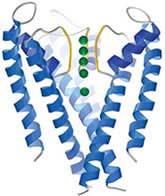Pores for thought

Hole story: channels like this underlie all our movements and thoughts. <br>© Nature/Morais-Cabral et al.
Dazzling snapshots show how ions power nerve signals round the body.
“Potassium channels underlie all our movements and thoughts,” says Rod MacKinnon of Rockefeller University in New York. His team has now unravelled the molecular mechanics of these minute protein pores. Some say the work merits a Nobel Prize.
Potassium (K+) channels power the transmission of nerve signals through the body and the brain by ushering K+ ions in and out of our cells. MacKinnon and his colleagues have taken high-resolution snapshots of the channels in action, revealing how, and how fast, individual K+ ions pass through1,2. It’s a remarkable feat – the K+ channel’s aperture is more than a hundred thousand times thinner than a sheet of paper, at under six Angstroms wide.
The role of K+ channels in nerves has made them “poster children”, but they are important throughout biology, says Christopher Miller, who studies ion channels at Brandeis University in Waltham, Massachusetts. They are present in the lowliest of amoebae and in the cells of the most complex brains.
The latest images of the K+ channel protein are “dazzling”, says Miller. They reveal how cells exploit the positive charge of K+ ions to produce the voltage that powers nerve signals.
For MacKinnon, seeing nature’s economy of design in the finest detail is just as fascinating: “It’s beautiful in how simple it is,” he says.
Channel hopping
Using a technique called X-ray crystallography to image different concentrations of K+ ions in K+ channels, MacKinnon’s team has shown the precise route that the ions take. “It’s almost like you see the ions going through the channel,” says MacKinnon.
The team has found that K+ ions can occupy one of seven positions, five of which only admit K+ ions. The ions hop through the pore, skipping a position at a time as more ions push them through from behind.
Measuring electrical fluctuations across the channel, McKinnon’s team calculate how much energy the K+ ions need to hop from position to position. The channel turns out to be so well tuned to K+ ions that they need almost no energy to pass through, thereby excluding other ions.
“This explains how [the channels] can be so fast yet so selective at the same time,” says Miller. How the channels shuttle only K+ ions faster than a speeding nerve impulse had baffled biologists for decades.
Hole new world
In 1999 MacKinnon received the Lasker Award in basic medical research for revealing the detailed structure of the K+ channel>3. He is now widely tipped as a future recipient of the Noble Prize. The latest work only strengthens that prediction, says Miller: “This is the kind of work that opens up a whole new world.”
Its MacKinnon’s systematic approach to deciphering how the K+ channel works, as well as the channel’s scientific significance, that warrants the ultimate scientific prize, says Fred Sigworth, a molecular physiologist at Yale University School of Medicine in New Haven, Connecticut. “These latest images are only the end of a string of wonderful discoveries by Mackinnon,” he says. “We’re talking about a body of work starting in the 1990s.”
It’s always nice to be recognized, admits MacKinnon, but a possible Nobel Prize does not motivate his research. “I am having so much fun doing the science,” he says. “Nothing can come close to the satisfaction that gives me.”
In fact, having reached “a very deep level of understanding” of K+ channels, MacKinnon now intends to move on to examine how cells open and close their ion channels.
References
- Morais-Cabral, J. H., Zhou, Y. & MacKinnon, R. Energetic optimisation of ion conduction rate by the K+ selectivity filter. Nature, 414, 37 – 42, (2001).
- Zhou, Y., Morais-Cabral, J. H., Kaufman, A. & MacKinnon, R. Chemistry of ion hydration and coordination revealed by a K+ channel-Fab complex at 2.0 A resolution. Nature, 414, 43 – 48, (2001).
- Doyle, D. A. et al. The structure of the potassium channel: molecular basis of K+ conduction and selectivity. Science, 280, 69 – 77, (1998).
Media Contact
All latest news from the category: Life Sciences and Chemistry
Articles and reports from the Life Sciences and chemistry area deal with applied and basic research into modern biology, chemistry and human medicine.
Valuable information can be found on a range of life sciences fields including bacteriology, biochemistry, bionics, bioinformatics, biophysics, biotechnology, genetics, geobotany, human biology, marine biology, microbiology, molecular biology, cellular biology, zoology, bioinorganic chemistry, microchemistry and environmental chemistry.
Newest articles

Superradiant atoms could push the boundaries of how precisely time can be measured
Superradiant atoms can help us measure time more precisely than ever. In a new study, researchers from the University of Copenhagen present a new method for measuring the time interval,…

Ion thermoelectric conversion devices for near room temperature
The electrode sheet of the thermoelectric device consists of ionic hydrogel, which is sandwiched between the electrodes to form, and the Prussian blue on the electrode undergoes a redox reaction…

Zap Energy achieves 37-million-degree temperatures in a compact device
New publication reports record electron temperatures for a small-scale, sheared-flow-stabilized Z-pinch fusion device. In the nine decades since humans first produced fusion reactions, only a few fusion technologies have demonstrated…





















